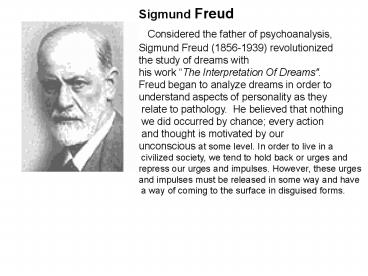Sigmund Freud - PowerPoint PPT Presentation
1 / 8
Title:
Sigmund Freud
Description:
Freud was particularly preoccupied with sexual content in dreams. He believed that sex was the root cause of what was happening in your dreams. ... – PowerPoint PPT presentation
Number of Views:192
Avg rating:3.0/5.0
Title: Sigmund Freud
1
Sigmund Freud Considered the father of
psychoanalysis, Sigmund Freud (1856-1939)
revolutionized the study of dreams with his
work The Interpretation Of Dreams". Freud
began to analyze dreams in order to understand
aspects of personality as they relate to
pathology. He believed that nothing we did
occurred by chance every action and thought is
motivated by our unconscious at some level.
In order to live in a civilized society, we tend
to hold back or urges and repress our urges and
impulses. However, these urges and impulses must
be released in some way and have a way of coming
to the surface in disguised forms.
2
To further help in interpreting the cryptic
images of our dreams, Freud classified the
images into the following five processes 1.
Displacement This occurs when the desire for one
thing or person is symbolized by something or
someone else. 2. Projection This happens when
the dreamer propels their own desires and wants
onto another person. 3. Symbolization This is
characterized when your repressed urges or
suppressed desired or acted out metaphorically.
3
4. Condensation This is the process in which the
dreamer hides their feelings or urges by
contracting it or underplaying it into a brief
dream image or event. The meaning of this dream
imagery may not be apparent or obvious. 5.
Rationalization This is seen as the final stage
of dreamwork where the dreaming mind organizes an
incoherent dream into one that is more
comprehensible and logical. Also known as
secondary revision.
4
- Freud was particularly preoccupied with sexual
content in dreams. - He believed that sex was the root cause of what
was happening in your dreams. - For Freud, every long slender or elongated
objects (i.e. knives, cigars, guns, etc) - represent the phallus, while any cavity or
receptacle (bowls, caves, tunnels, etc) denotes
the female genitalia.
5
However, these urges and impulses must be
released in some way and have a way of coming to
the surface in disguised forms. One way these
urges and impulses are released is through our
dreams. Because the content of the unconscious
may be extremely disturbing or harmful, Freud
thus believed that the unconscious expressed
itself in a symbolic language.
6
Freud categorized aspects of the mind into three
parts Id - centered around primal, pleasure,
desire, unchecked urges and wish
fulfillment. Ego - the conscious and the
rational, the moral and self-aware aspect of the
mind. Superego - the censor for the id. also
responsible for enforcing the moral codes of the
ego.
7
When we are awake, the impulses and desires of
the id are suppressed by the superego. Through
dreams, we are able to get a look into our
unconscious or the id. Because your guard is
down during the dream state, your unconscious
has the opportunity to act out and express the
hidden desires of the id. However, the
desires of the id can at times be so disturbing
and even psychologically harmful that a "censor"
comes into play to translates the id's
disturbing content into a symbolic form. This
helps to preserve sleep and prevent you from
waking up shocked at the images. This is where
you get all sorts of confusing dreams. When we
have trouble remembering our dreams, Freud
believe it was the superego at work and its goal
to protect the conscious mind from the
disturbing images and desires of the unconscious.
8
(No Transcript)































